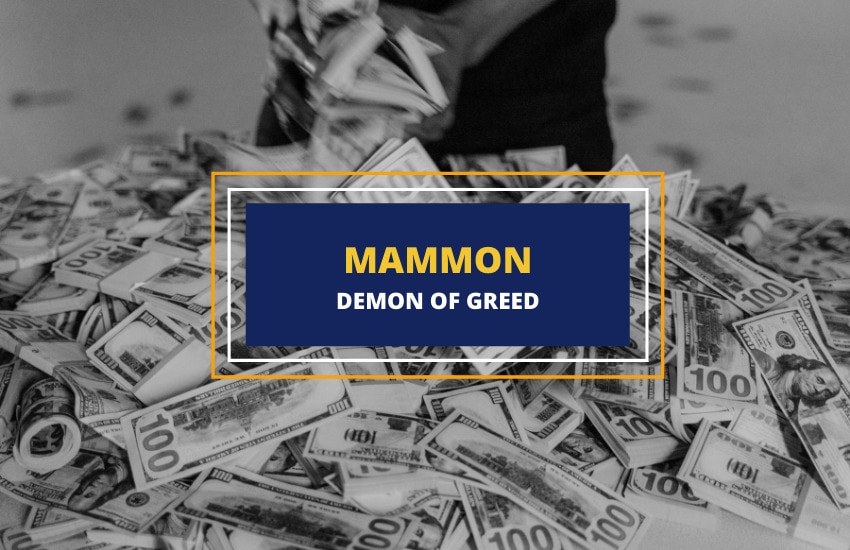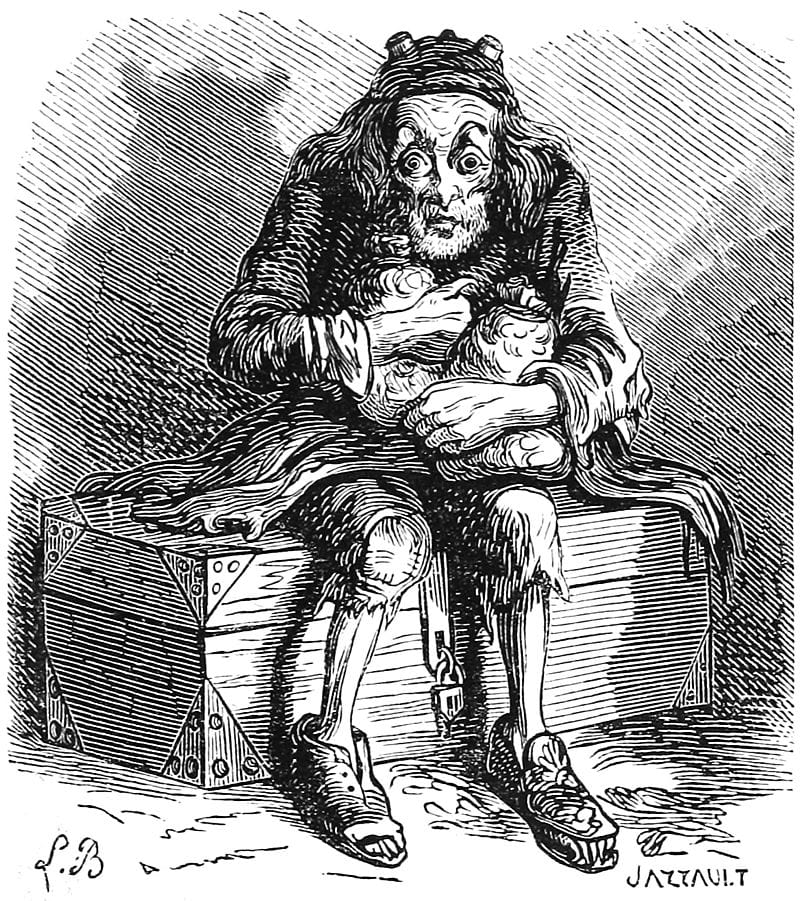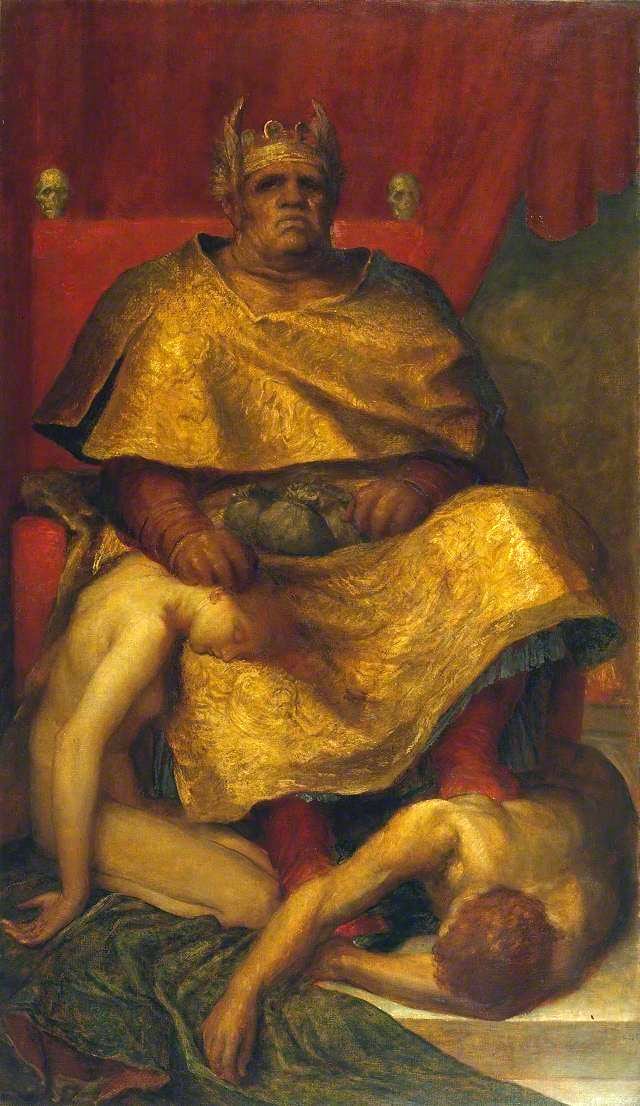
Table of Contents
Mammon is a biblical term famously used by Jesus in the Gospel of Matthew while referring to worldly wealth and riches. Over the centuries, it has become a pejorative term for money, wealth, and greed. Theologians and clergymen went so far as to personify Mammon as a demon of greed during the Middle Ages.
Etymology
The word mammon came into the English language by way of the Latin Vulgate. The Vulgate is the official Latin translation of the Bible used by the Roman Catholic Church. Originally the work of St. Jerome and commissioned by Pope Damasus I, it was completed in the late fourth century CE. Since then, it has undergone several revisions and was made the official text of the Catholic Church at the Council of Trent in the middle of the 16th century. Jerome transliterated the “mammon” from the Greek text. The translators of the King James Bible followed suit in 1611 when using the Vulgate to translate the Bible into English.
Mammona, in the late Latin of the Vulgate, is spelled mamonas in the Koine Greek or “common” Greek of the New Testament. Koine Greek spread rapidly during the reign of Alexander the Great and was the lingua franca for much of the ancient world from the fourth century BCE onward. The use of the term in the Greek text comes from the Aramaic word for wealth and accumulation of goods, mamona.
Aramaic was a Semitic language spoken by several groups in the region of the near east. By the time of Jesus, it had replaced Hebrew as the everyday language spoken by first-century Jews. Thus, it was the language Jesus spoke.
Biblical References to Mammon

Many demons, including Lucifer, Beelzebub, and Asmodeus, have a reference point in the Hebrew Bible connecting them to one of the many gods worshipped by peoples the ancient Jews interacted with, such as the Philistines, Babylonians, and Persians.
This is not the case with Mammon.
The references to mammon occur in the Gospels of Matthew and Luke when Jesus is teaching a crowd. Matthew 6:24 is the more famous passage because it is part of the well-known Sermon on the Mount.
“No one can serve two masters; for either he will hate the one and love the other, or he will be devoted to the one and despise the other. You cannot serve God and mammon.” Luke 16:13 is a parallel verse to this one. Jesus also mentions the word in verse 9 and verse 11.
The context of Luke 16 is an odd parable of Jesus’. A dishonest steward is commended by his master for acting shrewdly in dealing with the debts owed to the master by others. Jesus is teaching that the shrewd use of “unrighteous mammon” to make friends is good. On the surface, this seems to be contrary to the basic Christian teaching of honesty, justice, and righteousness.
By referring to it as unrighteous, Jesus is indicating that wealth and money have no inherent spiritual value, positive or negative, but this is not how he was understood much of the time.
Mammon quickly took on a negative connotation among early Christians who began to view the world they inhabited and its values as sinful, primarily the world of the Roman Empire. In the first three centuries, many Christian converts sought to make connections between their new faith and the religion of Rome with its pantheon of deities.
The Roman god Plutus made a good match. As the god of wealth, he controlled an immense fortune that could attract the covetousness of humans. He also played a significant role in the underworld as the source of mineral wealth and bountiful crops.
A follower of Jesus and Paul would have an easy time associating this wealthy deity from below ground with the master competing for one’s soul through worldly riches and avarice.
Personification of Mammon

The personification of Mammon has a long history in the Church. Jesus himself contributed to this when he paralleled God and mammon as competing masters. However, the idea that he taught Mammon exists as a physical being does not hold up etymologically.
Many references among the Church Fathers of the third and fourth centuries exist. Gregory of Nyssa connected Mammon with Beelzebub. Cyprian and Jerome associated Mammon with greed, which they viewed as a cruel and enslaving master. John Chrysostom, one of the most influential Church Fathers, personified Mammon as greed. John was known for his eloquence in preaching, Chrysostom meaning “golden-mouthed” in Greek.
The ordinary people of the Middle Ages incorporated superstition into everyday life and faith. Interest in the devil, hell, and demons was widespread, leading to numerous books written on the topic. These texts were intended to aid in resisting temptation and sin. Several included the personification of Mammon as a demon.
Peter Lombard wrote, “Riches are called by the name of a devil, namely Mammon”. In the middle of the fourteenth century, Fortalitium Fidei by Alfonso de Spina ranked Mammon highly among ten levels of demons. About a century later, Peter Binsfeld categorized demons according to what may be called their patron sins.
The idea of the “Seven Princes of Hell” was popularized from his list. Mammon, Lucifer, Asmodeus, Beelzebub, Leviathan, Satan, and Belphegor make up the seven.
Mammon in Literature and Art

Mammon also appears in literary works from this period, the most famous being John Milton’s Paradise Lost. The Faerie Queene is another example. One of the longest poems in the English language, it is an allegory extolling the greatness of the Tudor dynasty. In it, Mammon is the god of avarice who controls a cave full of riches.
Unlike many other demons, Mammon does not have an agreed-upon form depicted in art or illustrations. Sometimes he is a small, frail little man clutching bags of money, stooped in the shoulders.
Other times he is a magnificent emperor wrapped in grand, opulent robes. Or perhaps he is an enormous, red demonic creature. During the Middle Ages, wolves were associated with greed, so Mammon is sometimes depicted riding upon a wolf. Thomas Aquinas used the following description of the sin of avarice, “Mammon being carried up from Hell by a wolf”. Though Mammon does not appear in Dante’s Divine Comedy, the Greco-Roman god Plutus, mentioned earlier, has wolf-like features.
Mammon in Modern Culture
Most references to Mammon in modern culture occur in comics and video games. However, the most prominent appearance is in the role-playing game Dungeons and Dragons, in which Mammon is the Lord of Avarice and the ruler of the third layer of Hell.
In Brief
Today, few believe in Mammon as the demon of greed and wealth. His decline may be due in large part to recent trends in the translation of the New Testament. Most popular translations today prefer the term “money” as in “You cannot serve both God and money“.
A few other translations opt for “wealth” rather than “mammon” in their translations. However, the use of mammon can still be heard in the broader culture as a pejorative term for greed, riches, and the opulence of wealth.








